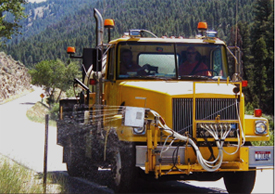
| CONNECTIONS |
IDAHO
ITD
HOME
511 TRAVEL SERVICES
IDAHO
DMV
ITD
NEWS
HIGHWAY
SAFETY
IDAHO STATE POLICE
STATE OF IDAHO
NIATT
NATIONAL
AASHTO
AAMVA
AAA of IDAHO
FEDERAL HIGHWAYS
FEDERAL AVIATION
IDAHO STATE POLICE
NHTSA
NTSB
TRB
U.S. DOT
TRANSPORTER
Archives
Milestones
Comments
Idaho
Transportation
Department
Office of Communications
P.O. Box 7129
Boise, ID 83707
208.334.8005
Fax: 208.334.8563

District
4 launches assault on roadside weeds
At a pace that could see a roadside jogger actually race around the truck working along the side of the road, the District 4 Vegetation Management crew has continued to roll down the local highways to do its part in keeping the roads presentable.
The process doesn’t appear to be the most important in District 4 operations, but the eradication of noxious and hazardous weeds has several benefits that Vegetation Forman Shawn Webb says makes the job still very necessary.
“We’re not really spraying fertilizer and we’re not watering the weeds,” Webb joked. “The average person doesn’t know we, the Idaho Transportation Department, are required to spray the weeds on our property.”
 On
a yearly basis, more than 4,000 acres are sprayed along side District
4 highways.
On
a yearly basis, more than 4,000 acres are sprayed along side District
4 highways.
“It doesn’t sound like a lot, but that is not in a big block,”
Webb said. “We’re not like an agricultural operation. We
go around a lot of obstacles, handling a lot of hazards and we’re
very weather dependant.”
Spraying road-side weeds is not the only responsibility of the five-man crew. In addition, the Vegetation crew has the responsibility of maintaining and landscaping of the district’s nine rest areas, replanting shoulders at the close of the construction season, and keeping weeds to a minimum in all maintenance yards, materials sources and building sites.
“Those places are out of site but not out of mind,” Webb said. Webb is joined with fulltime applicators Dave Jensen and Jeff Dionne as well as rest area maintenance men.
Dale Baughman and Todd Powers and three summer hourly employees work to keep the roadsides and rest areas more than presentable even as the job becomes even more difficult. There are currently 57 noxious weeds listed by the Idaho Department of Agriculture which the applicators must keep an eye out for while traveling down the highway.
However, spotting those weeds is not always the most difficult part of the job. Competing with the wind, weather conditions, and proximity of sensitive crops is easily the largest consideration when spraying – the chemical application could drift and kill many of the local crops.
“We have to stop if the wind is over 10 miles per hour,” Jensen said. “Sometimes you can’t keep going near some crops if it’s under 10. Some crops you can’t spray near if it’s one mile per hour.”
Using the breeze to their advantage can also be effective in keeping the spray away from those sensitive crops.
“We’ve managed to find a place to spray on just about any given day,” Webb said. He added that District 4 attempts to spray each mile and then spot spray troubled areas using two 1,500 gallon six-wheel spray trucks, a pickup, tractor with spray booms, an ATV sprayer or back-pack sprayer.
“Some of these weeds are pretty persistent and require multiple flushes – sprayings – per year,” Webb said. “There’s a lot of misinformed people out there. It’s not just spraying Round-up. A healthy shoulder is solid grass so the weeds have competition and get choked out.
“I call it spraying for noxious and obnoxious weeds,” Webb added. “We are required to control noxious weeds and we control the obnoxious weeds for our own benefit. It helps with sight distance, snow drifts, seeing wildlife and those types of reasons.”
For more information about noxious weeds, go to the Department of Agriculture Web site at http://www.agri.state.id.us and more about the ITD roadside vegetation management on the ITD Web site ( itd.idaho.gov .)
Published 8-24-07